Southern Baja California – Sun, Sea and Stars
(07th – 29th March, 2016)
Northern Baja was an exciting and adventurous experience for us – especially because of all the new impressions; we did ask ourselves, however, what was supposed to be so great about the Baja. As one of the most touristic areas of Mexico we had heard of beautiful beaches, wonderful towns, exceptionally friendly people and lots of Canadian and American “Snowbirds” (those not concerned with all the negative press) who spend the entire winter in the Baja. In the north, we had seen mostly poor and homely villages, no beaches worth mentioning and some somewhat friendly but mostly cool or reserved people. Not exactly the picture that was painted for us. In the South that all changed for the better and we soon understood why the Baja is, for the most part, considered beautiful.
Laguna Ojo de Liebre
The first town in southern Baja is Guerrero Negro on the pacific coast – not exactly a town one would call beautiful – though one of the biggest whale watching centers in Baja. Every year thousands of Gray whales meet for the calving season. Our goal, after one night in Guerrero (with stormy weather and rain but awesome food at the restaurant where we parked) was to drive out to the nearby whale watching camp at the Laguna Ojo de Liebre. We met up once again with Ingo, Elvira and Perla and shared one of the big Palapas that were built at each of the camping spots. The wind still blew quite hard directly on the coast, though the storm had slowly moved on and the weather was quiet enough, with blue skies, to set up our roof top tent once again. The following day we set out to get tickets for the whale watching tour, during that time of year there were over 2000 whales in the bay. “Impossible not to see any”, promised the man selling the tickets and since no other people were about we got to go on the tour with just the four of us sharing the lancha (skiff). Since the skiff was small we were very close to the surface of the water which made the experience all that more intense. Our driver opened the throttle speeding us across the bay for a good while before suddenly slowing down and telling us to be on the lookout. We were tense with anticipation looking all around hoping to spot one of the giant whales. It didn’t take too long either. After only a short time we spotted a huge rounded back almost silently breaking the surface, and then another and another coming up for a breath of air. Then one poked its head out of the water almost as if it was checking us out and another dove deep showing its complete tail fin. Before long we were surrounded, snapping photos as best we could in the rocking boat. Repeated calls of “over there!” or “over here!” had us twisting and turning in the boat not knowing in which direction to look in order not to miss anything. A mother with her young surfaced directly in front of us, and then as highlight a huge whale dove and his tail fin towering out of the water for a long moment as if to bid us farewell. An experience that won’t be forgotten, that’s for sure!
Bahia de Concepción
After another evening with Ingo and Elvira we went our separate ways heading south, though this time driving quite a lot farther crossing the peninsula once more to the Sea of Cortez. Not much of interest was seen along the way and one village was about as homely as the next. With our arrival on the other side, however, the scene changed dramatically. For the first time since arriving in Mexico we entered a pretty town, called Santa Rosalia. At first, we couldn’t believe our eyes, we had almost given up hope, but the little town was quite pretty! With colorful houses, flowers, clean well-kept streets, and a French bakery! We were so surprised by the sudden change of scenery that we couldn’t resist buying a bunch of things from the bakery. With all manner of bread and pastries, we headed back to our car only to learn the next Mexican lesson: If it is not 100% clear that the European named bakery is owned and operated by a European then it tastes exactly like all other bread and pastries in Mexico: dry, too sweet, tough or all three together – at least for us. Oh well, it hadn’t cost us too much for that lesson, but we won’t be taken in so lightly again.
Mulege
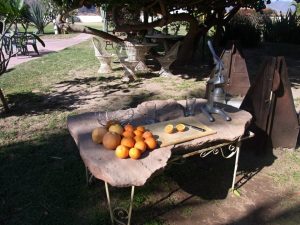 That evening we reached the town of Mulege, which lies to the north of the Bahia de Concepcion, and camped at the Hacienda de la Habana just outside of town. The Hacienda was an oasis of green and the camping area was in amongst the orange and tangerine trees and run by an incredibly friendly lady. She made us feel right at home and we were even allowed to help ourselves to as much of the juice oranges, tangerines, mandarine and pink grapefruits as we wished. There was even a juice press in the garden that we could use! Of course, our breakfast the next morning consisted of freshly pressed orange juice and a wonderful fruit salad with a variety of fruits we could find in the garden. After our awesome breakfast, we headed back to the town of Mulege to take care of the usual stuff, along the way we spotted a car wash (by hand) and being well overdue we decided to try it out. For the cost of a about $5 USD we hadn’t really expected all that much, to be honest. As we stood around and watched him work it soon became clear to us that he really meant to actually wash the car, and thoroughly too, especially when he brought out two plastic chairs for us to sit on while we waited. The landy shone like new after his ministrations, we could even see out of the windows again (no streaks) and with a little bit of tire-shine to finish it off! We had a bit of a bad conscience with the price especially with the quality of the work involved and so we gave him a big tip before driving our sparklingly clean auto into the town. In Mulege we also found the cleanest and most comfortable laundromat of our trip so far. They had hung pictures and sea art on the walls and everything was scrupulously clean and tidy – something that we had never seen in any laundromat – and for once it was a pleasure to do the washing. In the interim we shopped at the little village supermarket and for the first time since entering Mexico got up the nerve to try some of the famous Baja Fish Tacos at a street restaurant. We noticed that most of the street food vendors are particularly careful when it comes to hygiene and the potential for cross contamination, which surprised us given all the warnings about hygiene in Mexico. Almost every stand has a big bottle of hand-sanitizer, and money is almost never taken without wearing gloves (and if so they wash and disinfect their hands before touching any food preparation items again) also everything is freshly prepared right before our eyes. We were impressed and decided to be a bit braver in future and try different street foods more often – especially with the incredibly low prices! Enriched by our experiences we left Mulege that afternoon for our actual destination: a beach camping spot on the Bahia de Concepcion.
That evening we reached the town of Mulege, which lies to the north of the Bahia de Concepcion, and camped at the Hacienda de la Habana just outside of town. The Hacienda was an oasis of green and the camping area was in amongst the orange and tangerine trees and run by an incredibly friendly lady. She made us feel right at home and we were even allowed to help ourselves to as much of the juice oranges, tangerines, mandarine and pink grapefruits as we wished. There was even a juice press in the garden that we could use! Of course, our breakfast the next morning consisted of freshly pressed orange juice and a wonderful fruit salad with a variety of fruits we could find in the garden. After our awesome breakfast, we headed back to the town of Mulege to take care of the usual stuff, along the way we spotted a car wash (by hand) and being well overdue we decided to try it out. For the cost of a about $5 USD we hadn’t really expected all that much, to be honest. As we stood around and watched him work it soon became clear to us that he really meant to actually wash the car, and thoroughly too, especially when he brought out two plastic chairs for us to sit on while we waited. The landy shone like new after his ministrations, we could even see out of the windows again (no streaks) and with a little bit of tire-shine to finish it off! We had a bit of a bad conscience with the price especially with the quality of the work involved and so we gave him a big tip before driving our sparklingly clean auto into the town. In Mulege we also found the cleanest and most comfortable laundromat of our trip so far. They had hung pictures and sea art on the walls and everything was scrupulously clean and tidy – something that we had never seen in any laundromat – and for once it was a pleasure to do the washing. In the interim we shopped at the little village supermarket and for the first time since entering Mexico got up the nerve to try some of the famous Baja Fish Tacos at a street restaurant. We noticed that most of the street food vendors are particularly careful when it comes to hygiene and the potential for cross contamination, which surprised us given all the warnings about hygiene in Mexico. Almost every stand has a big bottle of hand-sanitizer, and money is almost never taken without wearing gloves (and if so they wash and disinfect their hands before touching any food preparation items again) also everything is freshly prepared right before our eyes. We were impressed and decided to be a bit braver in future and try different street foods more often – especially with the incredibly low prices! Enriched by our experiences we left Mulege that afternoon for our actual destination: a beach camping spot on the Bahia de Concepcion.
Playa Escondida
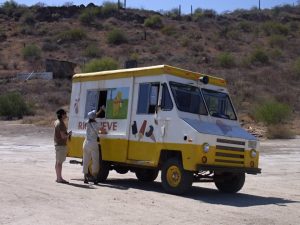 There are about 8 or 10 different beaches along the Bahia de Concepcion to choose from, though for us it ended up being only one: Playa Escondida – which translates to “hidden beach” and it is too. You can’t see it from the road and its only reachable by a bumpy dirt track that doesn’t look like it leads to a beach at all. The small cove is idyllic and peaceful with turquoise colored water and a half dozen or so palapas for the campers. Although we took the time to visit all the other beaches it was clear to us that this was the beach where we wanted to be. So, we set up our tent next to one of the palapas and moved-in. We had just moved into paradise! During the day, blue skies and sunshine, beautiful water to cool ourselves with during the hot afternoons and at night billions of stars and serenity. We watched pelicans drift elegantly mere centimeters from the water’s surface or swoop from high and dive headfirst to catch a meal; small stingrays patrolled the beaches along with a myriad other little fish and in the nearby Cacti the turkey vultures sunned themselves in the morning before making their rounds. One day we even saw a whale shark swimming in the shallows of the neighboring cove – a truly moving experience! Being isolated and hidden from the road the beach is not often visited and so is relatively quiet during the day as well. The only real traffic was from the various merchants who were selling everything from carpets to empanadas providing a little diversion. The biggest highlight was the ice-cream truck that came by every couple of days and looked like something out of a story book. You could hear him coming a while off with the Mexican equivalent of the ice-cream truck music -which apparently is the same throughout Mexico! Yep one could get used to this lifestyle and for some they like it so much that they spend 6 months a year at this one beach! Our camper neighbors flee the cold north in November and drive down in their big camper every year! Actually, we wanted to meet Ingo and Elvira at the Bahia de Concepcion though apparently, they must have driven past our beach and gone to one of the others. We couldn’t let them miss this little paradise that we had found, so we hopped into the Landy and went looking for them at the other beaches. Once at “our” beach they were equally as excited and didn’t want to leave. They ended up spending several weeks! We stayed a few more days and spent a lot of time together playing Settlers of Catan, cooking, baking bread and just whiling away the hours. Perla also enjoyed the time tremendously spending hours in the shallow water completely absorbed by the sea life all the while wagging her tail, bringing us a laugh every time we saw her.
There are about 8 or 10 different beaches along the Bahia de Concepcion to choose from, though for us it ended up being only one: Playa Escondida – which translates to “hidden beach” and it is too. You can’t see it from the road and its only reachable by a bumpy dirt track that doesn’t look like it leads to a beach at all. The small cove is idyllic and peaceful with turquoise colored water and a half dozen or so palapas for the campers. Although we took the time to visit all the other beaches it was clear to us that this was the beach where we wanted to be. So, we set up our tent next to one of the palapas and moved-in. We had just moved into paradise! During the day, blue skies and sunshine, beautiful water to cool ourselves with during the hot afternoons and at night billions of stars and serenity. We watched pelicans drift elegantly mere centimeters from the water’s surface or swoop from high and dive headfirst to catch a meal; small stingrays patrolled the beaches along with a myriad other little fish and in the nearby Cacti the turkey vultures sunned themselves in the morning before making their rounds. One day we even saw a whale shark swimming in the shallows of the neighboring cove – a truly moving experience! Being isolated and hidden from the road the beach is not often visited and so is relatively quiet during the day as well. The only real traffic was from the various merchants who were selling everything from carpets to empanadas providing a little diversion. The biggest highlight was the ice-cream truck that came by every couple of days and looked like something out of a story book. You could hear him coming a while off with the Mexican equivalent of the ice-cream truck music -which apparently is the same throughout Mexico! Yep one could get used to this lifestyle and for some they like it so much that they spend 6 months a year at this one beach! Our camper neighbors flee the cold north in November and drive down in their big camper every year! Actually, we wanted to meet Ingo and Elvira at the Bahia de Concepcion though apparently, they must have driven past our beach and gone to one of the others. We couldn’t let them miss this little paradise that we had found, so we hopped into the Landy and went looking for them at the other beaches. Once at “our” beach they were equally as excited and didn’t want to leave. They ended up spending several weeks! We stayed a few more days and spent a lot of time together playing Settlers of Catan, cooking, baking bread and just whiling away the hours. Perla also enjoyed the time tremendously spending hours in the shallow water completely absorbed by the sea life all the while wagging her tail, bringing us a laugh every time we saw her.
With a heavy heart, we finally left the fantastic beach and our friends, though this time our paths would not cross again (at least on this trip) as our destination lay south and for them they would head back up north.
Loreto – in the Chicken Coop
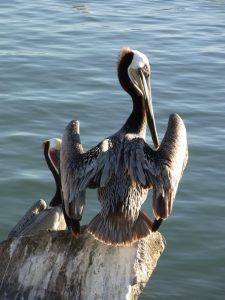 Quite a bit farther south we visited our first Pueblo Magico. Mexico awards towns that are especially pretty, historical, or particularly interesting the title of Pueblo Magico or “Magic Town” and as we discovered Loreto it is definitely worth the visit. The little town on the Sea of Cortez is exceedingly pretty with a romantic town center and a quaint little harbor with lots of Mexican flair to be had around the historical center. We camped at a small campground within walking distance from town and took the opportunity to explore our surroundings and stroll through the pretty lanes. We stopped at one of the many little restaurants for some fish tacos and treated ourselves to an ice cream – wonderful! The harbor was filled with pelicans and we sat on one of the many benches and simply watched the show. They would circle the harbor then suddenly dive for a fish from 20 or 30 meters up, either coming up empty handed or quickly swallowing their catch before taking off once again for another fly by – impressive! For two days, we enjoyed our stopover in Loreto, only the nights ended up being a bit strenuous. At some point in the night we were awoken by a rooster and wondered “is it morning? But It is still dark outside”, checking the time revealed that it was 3am! The rooster had obviously made some kind mistake and thought it was time to wake up. Though then another picked up the call and then another and before long the entire town was crowing! Apparently, every single person in Loreto has at least one bloody rooster and they were all awake and doing their best to ensure that everyone else was too. The concert kept going the whole night and first at around 7am did it finally peter out. Earplugs didn’t help much either with the level of noise that they had produced. At first, we thought, rather naively, that it was a onetime mistake, some atmospheric phenomena that caused the roosters to wake up in the middle of the night, but we were sadly mistaken. The concert began at around the same time the following night too! When you sleep in a tent it’s like sleeping outside so you can imagine that our nights were extremely short. We were really annoyed with the whole situation and dreamed up all manner of chicken dishes we could make with so many roosters at our disposal. Unbeknownst to us at that time it would not be the last time that we were woken by roosters at all hours of the night, not by a long shot.
Quite a bit farther south we visited our first Pueblo Magico. Mexico awards towns that are especially pretty, historical, or particularly interesting the title of Pueblo Magico or “Magic Town” and as we discovered Loreto it is definitely worth the visit. The little town on the Sea of Cortez is exceedingly pretty with a romantic town center and a quaint little harbor with lots of Mexican flair to be had around the historical center. We camped at a small campground within walking distance from town and took the opportunity to explore our surroundings and stroll through the pretty lanes. We stopped at one of the many little restaurants for some fish tacos and treated ourselves to an ice cream – wonderful! The harbor was filled with pelicans and we sat on one of the many benches and simply watched the show. They would circle the harbor then suddenly dive for a fish from 20 or 30 meters up, either coming up empty handed or quickly swallowing their catch before taking off once again for another fly by – impressive! For two days, we enjoyed our stopover in Loreto, only the nights ended up being a bit strenuous. At some point in the night we were awoken by a rooster and wondered “is it morning? But It is still dark outside”, checking the time revealed that it was 3am! The rooster had obviously made some kind mistake and thought it was time to wake up. Though then another picked up the call and then another and before long the entire town was crowing! Apparently, every single person in Loreto has at least one bloody rooster and they were all awake and doing their best to ensure that everyone else was too. The concert kept going the whole night and first at around 7am did it finally peter out. Earplugs didn’t help much either with the level of noise that they had produced. At first, we thought, rather naively, that it was a onetime mistake, some atmospheric phenomena that caused the roosters to wake up in the middle of the night, but we were sadly mistaken. The concert began at around the same time the following night too! When you sleep in a tent it’s like sleeping outside so you can imagine that our nights were extremely short. We were really annoyed with the whole situation and dreamed up all manner of chicken dishes we could make with so many roosters at our disposal. Unbeknownst to us at that time it would not be the last time that we were woken by roosters at all hours of the night, not by a long shot.
La Paz
After two nights in the chicken coop we headed south once again towards La Paz. From there we would take the ferry to the main land though not quite yet as we wanted to visit the famous Cabo San Lucas first. However, we decided to buy our tickets for the crossing then, just to be on the safe side since they only have limited cabins available and we definitely wanted to have one for the 18 hours that we were expected to spend on the boat. The town has a wonderful sea-side promenade with lots of cafes and restaurants but overall not exactly the most pretty of cities, but also not exactly ugly. In La Paz, we also had our first Mexican Torta, a kind of hot sandwich or hot sub that is especially delicious. The best Tortas in La Paz were at Doña Mini, a small road-side stand in the 3rd or 4th row of parallels up from the beach. We found him in the travel application (iOverlander) that we had been using since crossing into Mexico. We didn’t only get a great lunch but also a free Spanish lesson to boot! Another highlight for us was a visit to the local Walmart, although we had mostly avoided Walmarts in the USA and Canada in Mexico, however, we were quite happy to see one as they tended to have a much better selection of veggies, fruits and specialty items that we were beginning to miss.
Cabo Pulmo
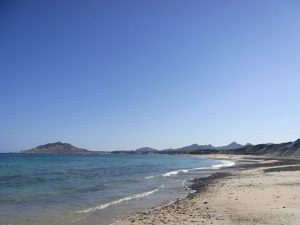 We had heard and read so many things about the Cabo Pulmo national park – amongst which it being the prettiest destination in Baja! Though, along the way there we noticed that something had suddenly changed. For the most part we had spent most of our time in not very touristy areas, though in Cabo Pulmo it was the complete opposite. We heard English spoken almost everywhere; our spotty disjointed Spanish was no longer necessary and the place was crawling with “Snowbirds” who were there in their huge RV’s along with their “big-boy” toys escaping the harsh northern winters. Quads and ATV rentals along with all manner of tour operators lined the streets giving the feeling that one had somehow left Mexico behind and landed somewhere back in the USA. The prices also seemed to have jumped through the roof with the worst being in Los Barriles, a real Snowbird meeting point, where we ended up spending an overpriced night on an ugly campground.
We had heard and read so many things about the Cabo Pulmo national park – amongst which it being the prettiest destination in Baja! Though, along the way there we noticed that something had suddenly changed. For the most part we had spent most of our time in not very touristy areas, though in Cabo Pulmo it was the complete opposite. We heard English spoken almost everywhere; our spotty disjointed Spanish was no longer necessary and the place was crawling with “Snowbirds” who were there in their huge RV’s along with their “big-boy” toys escaping the harsh northern winters. Quads and ATV rentals along with all manner of tour operators lined the streets giving the feeling that one had somehow left Mexico behind and landed somewhere back in the USA. The prices also seemed to have jumped through the roof with the worst being in Los Barriles, a real Snowbird meeting point, where we ended up spending an overpriced night on an ugly campground.
Not quite adjusted to the sudden change we arrived at the Cabo Pulmo national park after driving over a bumpy dusty dirt road. Without question a wonderful beach, though with rather limited camping (at least with a vehicle) and sadly also a rather strange atmosphere that seemed almost somehow fake in comparison to the rest of Baja. Everything was overpriced and packed with foreign tourists giving the whole a somehow phony impression. We were disappointed; we had imagined something much different and even headed back to La Paz to see if we could rebook the ferry and skip the rest of southern Baja especially the even more touristy Cabo San Lucas. Though, it wasn’t to be, we could get a spot on the ferry for the vehicle but all the cabins were already booked – anywhere else we would have gone with it, but we hadn’t had any experience with Mexican ferries so didn’t want to take the risk of being without a cabin, which ended up being a very good decision.
Todos Santos
Since we still had a week to go we decided to drive the southern loop in the other direction heading once again to the Pacific side. Todos Santos was also a rather touristy town but pretty and quaint. We camped out at the nearby free “surfer” beach for a few nights. The waves were huge – a paradise for surfers but not much for swimming. With the town fully explored we spontaneously changed our minds about visiting Cabo San Lucas – after all it is the most famous destination on the Baja and we were just around the corner.
Cabo San Lucas
Easter was just a day or two away and we had been “warned” by just about everyone that “Semana Santa” is a huge party in Mexico. We asked ourselves if it was such a good idea to be visiting Cabo San Lucas especially then, though then again, we were told it wouldn’t matter where we were it would be full everywhere. So, despite the warnings we headed to the most southerly tip of Baja where the Sea of Cortez meets the Pacific. Without question, extremely touristy, though there is definitely a reason for it, the beautiful white sandy beaches, turquoise waters and wonderful rock formations make it uniquely beautiful. We only wanted to take a quick detour there, though the magic of Cabo San Lucas drew us in and we decided to spend two nights. The camping prices were as expected, extremely high and for about $25 the most expensive in Mexico and that also didn’t mean that it was nice either. The campground was filled with snowbirds and we had to join the sardine can and make our camp on a concrete platform next to the main road. At least the beach was in walking distance. The next day was good Friday and so we ventured out onto the beach and ended up spending the entire day doing absolutely nothing. The day before we saw mostly foreigners, though locals had now traveled from far and wide and retaken their beach. We thought that the beach was full the day before, apparently, we had no idea what full meant! Some places it appeared that Mexican families occupied every available centimeter along with their huge coolers, party tents, chairs and tables showing everyone what it really means to party! A few bands were playing along the beach and the number of peddlers had increased tenfold from the day before. It took a while, but we managed to find a clear spot, we then rented an umbrella, spread our blankets out made our selves comfortable and enjoyed the colorful spectacle in front of us, it was almost like being at the theatre. It was somewhat strange at the beginning, though after only a few minutes we just sat back and enjoyed watching the Mexicans partying – they have a contagious zest for life.
Easter at the Cascada Sol de Mayo
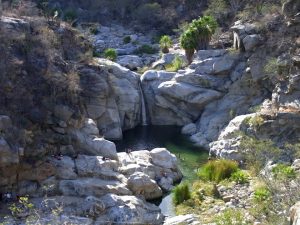 Two days of beach life, crowds and hustle and bustle were enough for us and so, on Saturday, we left Cabo San Lucas behind for Finca Sol de Mayo and the similarly named waterfall, which lies somewhat more inland. We had gotten a tip from other travelers not to miss the spot and as we arrived we knew that it was a really good tip. The farm was idyllic and quite far from the main road making it a tranquil spot; somewhat higher it provided a wonderful panorama of the valley below and the small campground perched next to the cliff face had a spectacular view. Since it was quite hot we grabbed our swim suits after we set up our camp and headed for the waterfall. A 20-minute walk along a craggy trail led us down into the valley to the small river, pool, and waterfall. The waterfall falls from a high rock wall into a large pool and from there into smaller pools before turning into a stream farther down the canyon. What a wonderful spot and even better the water was clean enough to go swimming – something we took for granted north of the border. The only downside about going to the waterfall and pool to cool down was that the way back to camp was all steep uphill so that once we arrived back at camp there wasn’t much remaining of the refreshment. Though, thankfully, it cooled down after sunset and after the hustle and bustle of Cabo San Lucas we really enjoyed the tranquility, stillness, and starry night sky above us. On Easter Sunday, however, the locals invaded the waterfall as well, arriving in caravans carrying huge coolers and all other manner of picnic stuff. After our extensive Easter Sunday breakfast, we decided to head down to the waterfall too and spend the hottest part of the day in the cool waters – again surrounded by a bunch of boisterous Mexicans. That evening we cooked up a holiday feast and slept once again under a magnificent canopy of stars.
Two days of beach life, crowds and hustle and bustle were enough for us and so, on Saturday, we left Cabo San Lucas behind for Finca Sol de Mayo and the similarly named waterfall, which lies somewhat more inland. We had gotten a tip from other travelers not to miss the spot and as we arrived we knew that it was a really good tip. The farm was idyllic and quite far from the main road making it a tranquil spot; somewhat higher it provided a wonderful panorama of the valley below and the small campground perched next to the cliff face had a spectacular view. Since it was quite hot we grabbed our swim suits after we set up our camp and headed for the waterfall. A 20-minute walk along a craggy trail led us down into the valley to the small river, pool, and waterfall. The waterfall falls from a high rock wall into a large pool and from there into smaller pools before turning into a stream farther down the canyon. What a wonderful spot and even better the water was clean enough to go swimming – something we took for granted north of the border. The only downside about going to the waterfall and pool to cool down was that the way back to camp was all steep uphill so that once we arrived back at camp there wasn’t much remaining of the refreshment. Though, thankfully, it cooled down after sunset and after the hustle and bustle of Cabo San Lucas we really enjoyed the tranquility, stillness, and starry night sky above us. On Easter Sunday, however, the locals invaded the waterfall as well, arriving in caravans carrying huge coolers and all other manner of picnic stuff. After our extensive Easter Sunday breakfast, we decided to head down to the waterfall too and spend the hottest part of the day in the cool waters – again surrounded by a bunch of boisterous Mexicans. That evening we cooked up a holiday feast and slept once again under a magnificent canopy of stars.
Farewell Baja
Our ferry to the mainland was for the Tuesday following Easter Monday so we only had one day left on Baja and we wanted to use the day to explore a little more closing the loop tour we started a few days prior. Los Barriles lies on the Sea of Cortez side of the peninsula, which we reached by way of a side road. A short drive along the shore later we discovered a wonderful and lonely beach which was perfect for swimming. Since we felt quite safe we decided to boondock at a somewhat hidden rocky beach and enjoyed our last idyllic evening on the peninsula before heading for the ferry in La Paz. Our time on the Baja was adventurous for us with lots of new experiences, though we heard from many that the Baja is “Mexico Light” and that real Mexico lies on the mainland – and that started with the ferry crossing.
More Photos on Flickr: Southern Baja

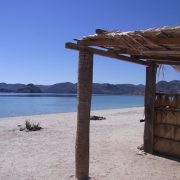
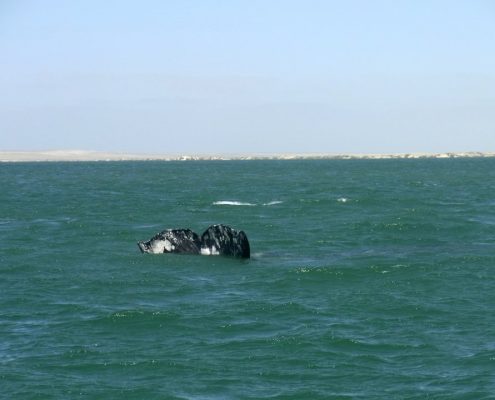
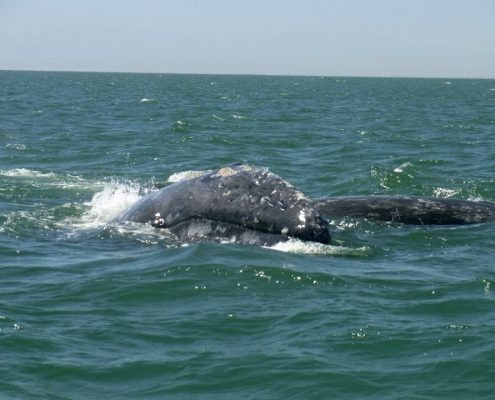
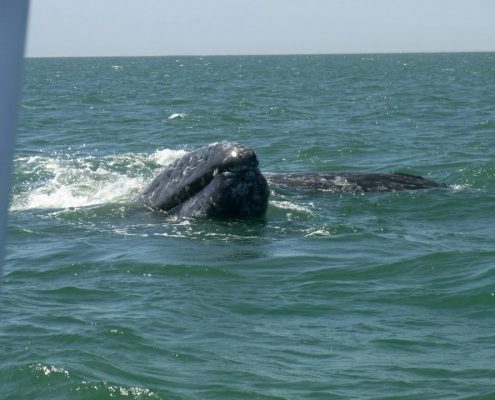
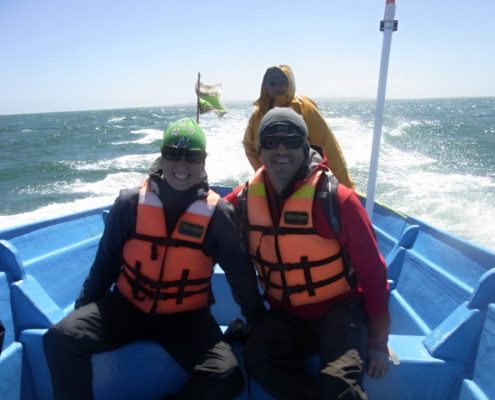
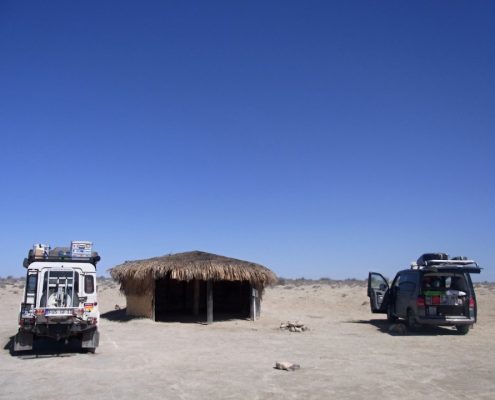
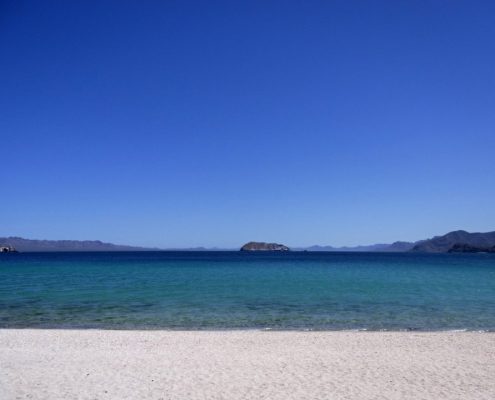
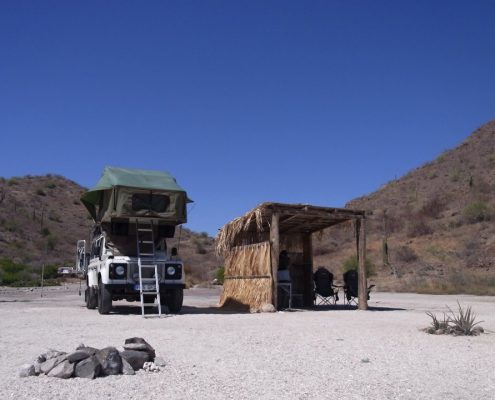
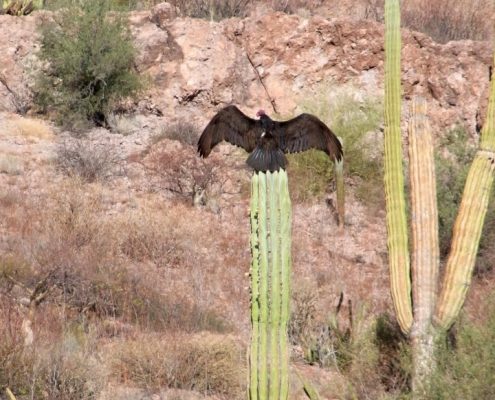
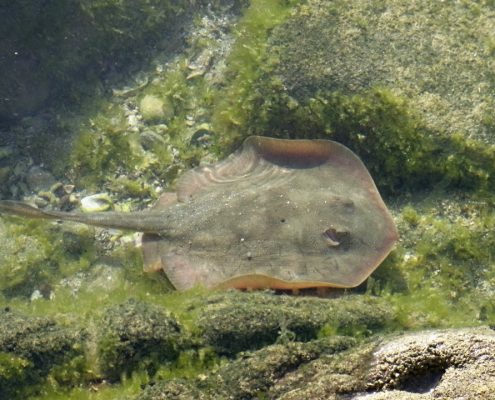
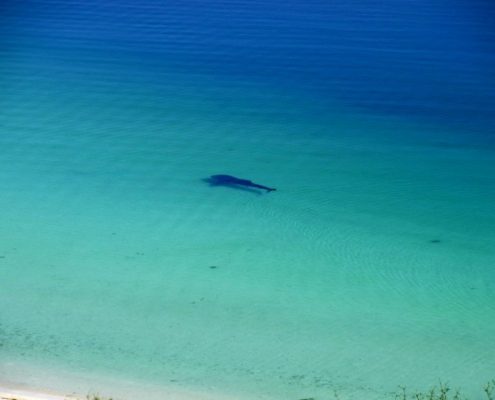
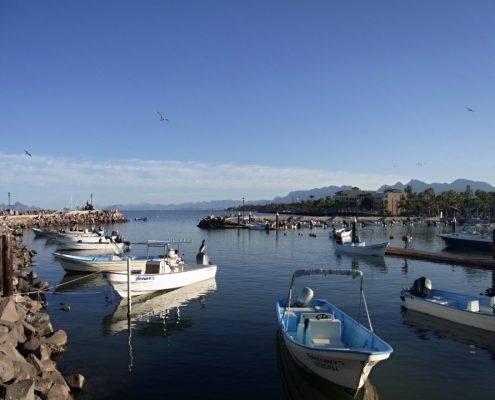
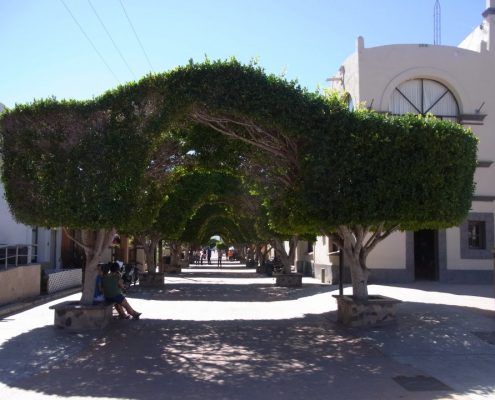
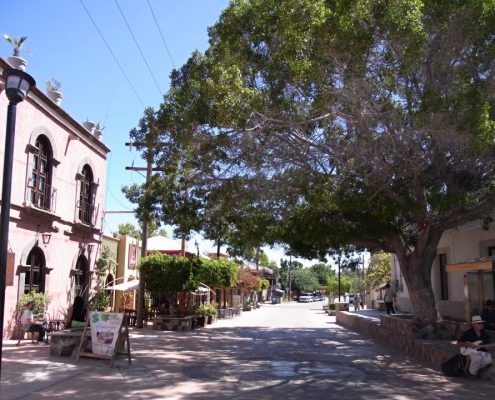
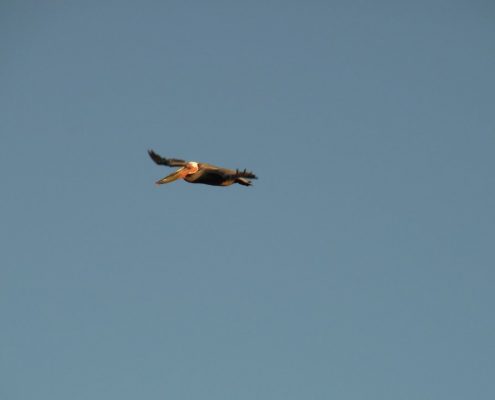
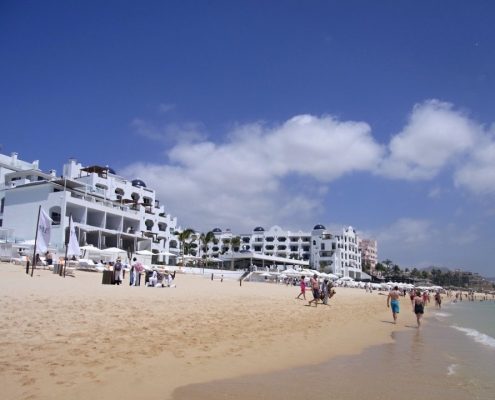
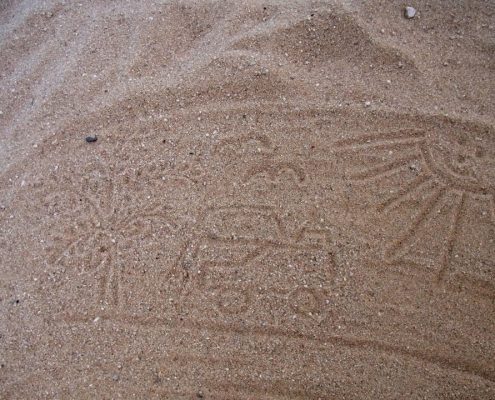
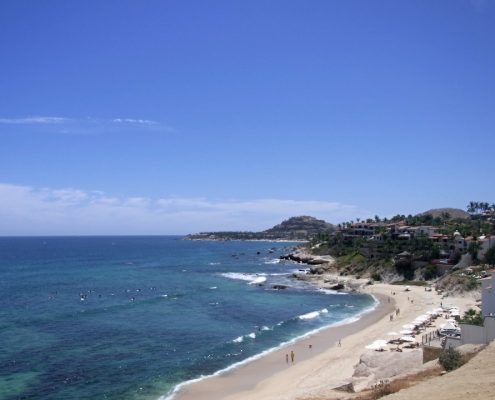
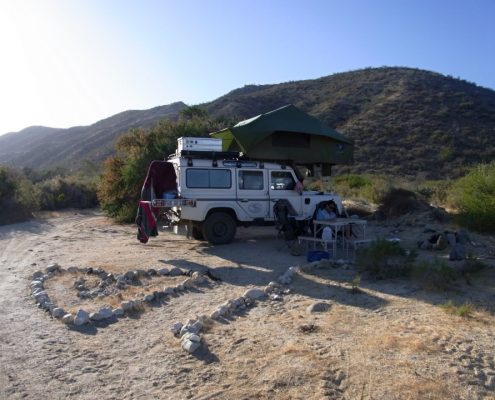
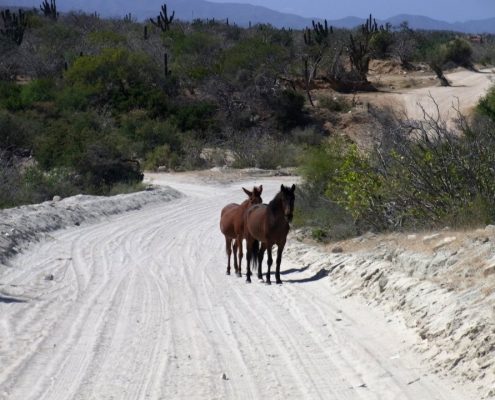
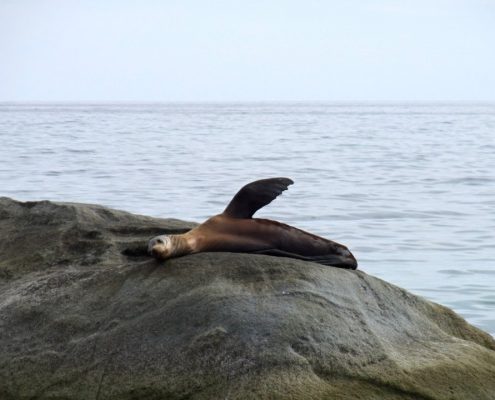
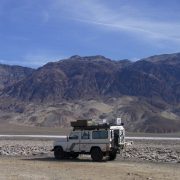
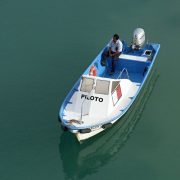
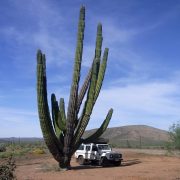
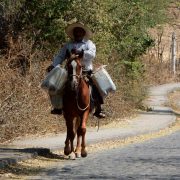
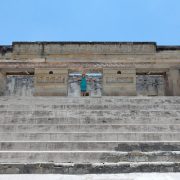
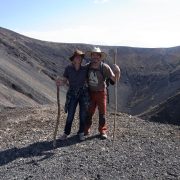
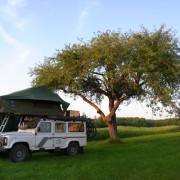
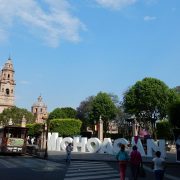


Thanks enjoyed reading it even though it was a year behind.
is that correct? this post is dated last year? Did I miss something
No Tom it is correct, we are in fact a year behind in our blog posts :)